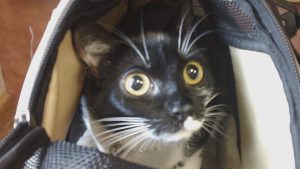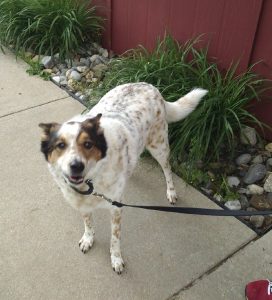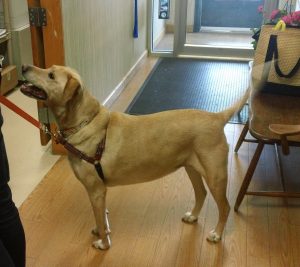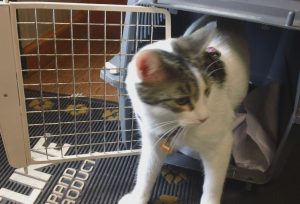Thanks to all who joined us for the free Dental Seminar at Belle Mead Animal Hospital on May 6, 2017. We were happy to see so many dogs and cats come in with their owners eager to learn how to grade their pet’s teeth. In case you missed it, following is a review of what we went over that day.


While the pets enjoyed some quiet time in the kennel area, Dr. Martins began by explaining how Belle Mead Animal Hospital is one of only 12-15% of animal hospitals throughout the United States and Canada accredited by the American Animal Hospital Association (AAHA). That means we offer our clients an elevated standard of care, including dentistry, surgical and anesthetic procedures, that might not always be found in other animal hospital environments.
Pet dentistry is one of the most important services BMAH offers clients. Helping pet owners learn how to grade their own pet’s teeth will go a long way in ensuring they understand when to contact their veterinarian for an oral exam if they notice something awry in their pet’s mouth in between annual check-ups.
Dr. Martins then introduced Mark Sopko, dental technician, who has been with BMAH over 10 years. Mark has been practicing as a dental technician for over 20 years. He often travels around the country teaching at other animal hospitals and presenting at conferences.

Mark went on to explain the importance of grading pet’s teeth, charting the results, and taking digital dental x-rays of the pet’s mouth to zero in on the exact issue. X-rays allow the veterinarian and dental technician to see what the naked eye cannot see that lies below the gum line.
Mark showed clearly with photos through a slide presentation how a pet’s mouth is affected by periodontal disease. Without regular dental cleanings and daily at-home maintenance, plaque and tartar build up in a pet’s mouth similar to humans. The result is rotting gums and bone loss.
Clients are often concerned about anesthesia and cost. Before a pet is considered for anesthesia, blood work is done to ensure the pet is healthy enough to undergo anesthesia. BMAH offers a proactive, highly skilled veterinary team that properly support their patients going under anesthesia every time with an IV (intravenous) catheter, IV fluids, warmth, and continuous blood pressure (BP) monitoring that will help insure that pet anesthesia can be just as safe as human anesthesia. With regular exams, routine cleanings, and at-home care, the risk of dental disease is decreased and therefore the costs for the pet dental work can be lower. In fact, pet dental care costs are comparable to what humans experience at their own dentist.
The greatest risk lies in waiting to schedule a dental exam until the pet is much older, after periodontal disease has set in. Remember, a 5 year old pet is the approximate equivalent age of a 30 year old person. Would you wait 30 years before having your first dental exam? But that is the reality. Our pets age much faster than humans do, and dental disease can set in before we know it.


Veterinarians and dental technicians treat pet dental care in much the same way as humans – we probe, we chart, we clean and polish, and we add fluoride to protect the teeth. We take full mouth digital x-rays on every pet to ensure accuracy of where dental problems might be hiding from the naked eye.
Have you heard about non-anesthesia cleanings? We do not recommend this and do not practice dentistry without anesthesia at BMAH. You cannot get up under the gum line to reach the bacteria without anesthesia and you risk hurting the pet when he/she moves around.

Mark offered many visuals during his presentation to show exactly the kinds of dental problems he’s seen, from broken and loose teeth, to gum disease leading to fractured jaws. If dental disease is left untreated and a root starts to decay, it can actually fuse with the bone and become bone – now the pet is in danger of a broken jaw.
If the veterinarian or technician sees a missing tooth and/or red areas in the mouth, that indicates something is happening under the gum line. Swelling on the pet’s face typically indicates a tooth problem. The animal has most likely broken the tooth. Bacteria and infection goes up the root canal and the infection reaches into the face. We also need to rule out cancer when swelling and/or lumps and bumps are evident.
During a dental exam, each tooth gets probed and charted. We give estimates of cost, but we don’t know in total what is involved until we see the x-ray. Some dentals are relatively quick 20-40 minutes total anesthetic time depending on the extent of plaque and tartar under the gums and whether or not extractions are found to be required. The x-rays are also used for positioning. We always do a post x-ray to make sure we achieved the desired result.
Signs of pet oral pain were discussed – loss of weight, crying, chewing with head to the side, rubbing face on things, drooling, no longer social (they hide), they bite when they didn’t bite before, dropping food, vomiting, matted fur (the pet can’t clean themselves without experiencing pain). Sometimes there are no signs at all (their DNA says they will become prey if they show weakness, so pets hide pain very well).
Number one at-home care recommended is daily brushing, using treats as rewards, and using gauze as the “brush.” Take it slow, step by step. If you watch TV with your pet in your lap, keep gauze and toothpaste right next to the couch. Start off with gauze because sometimes it’s easier than a toothbrush. There are different types of gauze, and for cats we recommend a tighter weave.
Please make note: mouth disease leads to other disease – the blood spreads disease into the heart, liver, kidneys – anywhere the blood will take it, even the brain.


Folks were given the chance to ask questions, and after the presentation, they were escorted back to the exam rooms to learn to grade their own pet’s teeth from stages one through four. Everyone left with a Dental Goodie Bag! Thanks to all those who participated!
Recommended Reading:
Anesthesia – is it safe
Pet dental care – case study
Why animals need anesthesia for complete dental cleaning – Ask the Vet

Joe Martins, DVM, Belle Mead Animal Hospital


